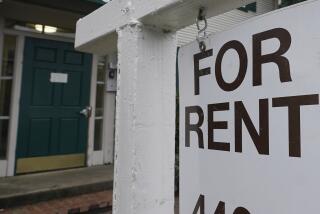Postscript: Crackdown on Illegal Housing Brings Cleanup
When Tomas and Isabel Gutierrez came to the United States 23 years ago, they lived in a tiny four-room shanty behind their landlordâs home in a quiet residential area of Anaheim.
The couple have done well. Today, they own their former landlordâs house and the one next door, but the shanty and a one-room shed they once rented out are gone.
They were torn down two months ago by Tomas Gutierrez because they were in violation of the cityâs housing code.
The Gutierrezes are among the 50 homeowners--in an area bordering La Palma Avenue and North Street from Pauline Street to Olive Street --cited in October during a continuing crackdown on substandard housing, begun after the city received complaints about the shacks from the Central City Neighborhood Council, a neighborhood improvement advisory board.
Officials found groups of people--at times seven or eight to a room--living without heat or plumbing in plywood shacks and converted garages hidden behind or next to the middle-class houses in the area, said Richard La Rochelle, senior code-enforcement officer.
The homeowners âwere renting those shacks for a nice piece of money,â he said.
Of the 50 homeowners cited, 30 already have complied with notices to take down the structures and clean up yards, and others have begun the work. He called the project a success, saying that only seven landlords will have to be prosecuted for non-compliance.
Further, La Rochelle is confident that the homeowners will not attempt to rebuild the structures, saying, âI donât think theyâll want to go to all that trouble (with the city) again. Weâll be keeping an eye out in case we see something there.â
In the Gutierrezesâ case, La Rochelle said, six to eight people were found in the four-room shanty, one male with âseveral childrenâ in the shed and several people in the garage.
âBootlegged Gas Linesâ Found
âThe kitchen had bootlegged gas lines connected to the main house,â he said. âIt was a fire hazard. We found the only door had been wired shut . . . .â When city inspectors visited the site, he said, the renters told them that they were paying $50 a month each. In a subsequent visit by inspectors, however, he said, the tenants denied that they were paying anything.
He said that on March 22, the Gutierrezes will have to show proof in court that they are in compliance with the housing code and pay $500 for court costs and a $500 fine for enforcement costs. Other homeowners cited face similar court procedures and fines.
For their part, the Gutierrezes maintain that they never intended to rent rooms to anyone. âMy husband didnât want to rent to them at first,â Isabel Gutierrez said, âbut the man and his wife and children (who lived in the one-room shed) arrived on our doorstep looking for a place to stay. He was almost crying.â Later, the other tenants, all relatives of the man, arrived, also looking for shelter, she said.
Isabel Gutierrez also disputed La Rochelleâs recounting, saying that four men lived in the shanty and that the rent was $50 a month for all, that a married couple with three children lived in the garage and paid $50 a month, and that another young couple with a child lived in el cuartito (the little room) for nothing.
La Rochelle said he does not know how many people have been forced to move because of the crackdown, but that all were referred to the city community development office and housing authority for help in finding new quarters. Because the tenants were living in illegally built housing, he said, they did not qualify for relocation funds from the city.
More to Read
Sign up for Essential California
The most important California stories and recommendations in your inbox every morning.
You may occasionally receive promotional content from the Los Angeles Times.






